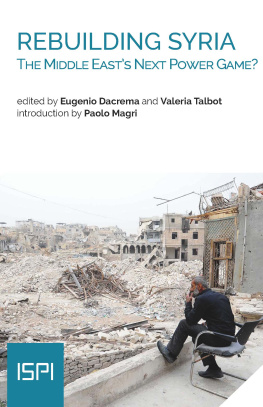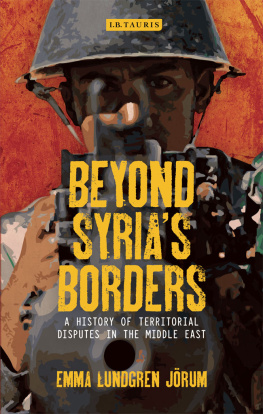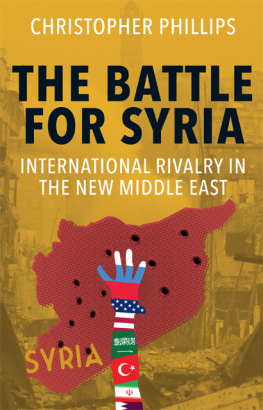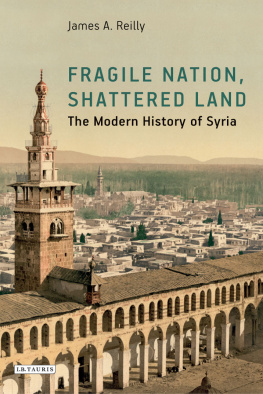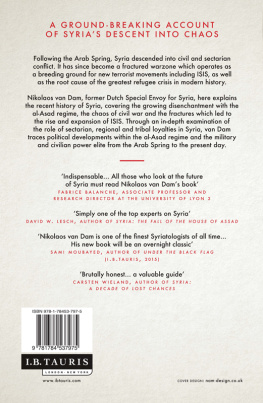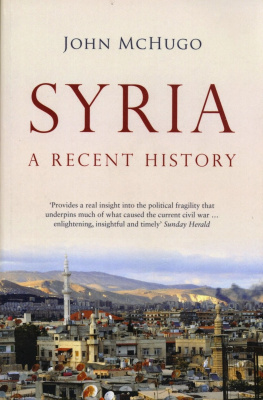
Syria
David W. Lesch
Polity
Copyright David W. Lesch 2019
The right of David W. Lesch to be identified as Author of this Work has been asserted in accordance with the UK Copyright, Designs and Patents Act 1988.
First published in 2019 by Polity Press
Polity Press
65 Bridge Street
Cambridge CB2 1UR, UK
Polity Press
101 Station Landing
Suite 300
Medford, MA 02155, USA
All rights reserved. Except for the quotation of short passages for the purpose of criticism and review, no part of this publication may be reproduced, stored in a retrieval system or transmitted, in any form or by any means, electronic, mechanical, photocopying, recording or otherwise, without the prior permission of the publisher.
ISBN-13: 978-1-5095-2755-7
A catalogue record for this book is available from the British Library.
Library of Congress Cataloging-in-Publication Data
Names: Lesch, David W., author.
Title: Syria / David W. Lesch.
Description: Cambridge, UK : Polity Press, 2019. | Includes bibliographical references and index.
Identifiers: LCCN 2018032455 (print) | LCCN 2018034955 (ebook) | ISBN 9781509527557 (Epub) | ISBN 9781509527519 | ISBN 9781509527519(hardback) | ISBN 9781509527526(pbk.)
Subjects: LCSH: Syria--History--20th century. | Syria--History--21st century. Classification: LCC DS95 (ebook) | LCC DS95 .L47 2019 (print) | DDC 956.9104--dc23
LC record available at https://lccn.loc.gov/2018032455
The publisher has used its best endeavours to ensure that the URLs for external websites referred to in this book are correct and active at the time of going to press. However, the publisher has no responsibility for the websites and can make no guarantee that a site will remain live or that the content is or will remain appropriate.
Every effort has been made to trace all copyright holders, but if any have been overlooked the publisher will be pleased to include any necessary credits in any subsequent reprint or edition.
For further information on Polity, visit our website: politybooks.com

A Political Map of Syria
Preface
Syria has become something of a second home for me. Since my first visit to the country in 1989 to conduct research on my dissertation, I have visited it over thirty times, staying for months at a time on occasion. I have, therefore, come to know Syria quite well for a Westerner, often learning about the country from the inside out. Although nothing compared to the suffering of Syrians today, it has been one of the most difficult periods of my life to see a number of friends and acquaintances on both sides of the conflict having been killed or displaced as the result of the civil war that has raged since 2011. One of those people was Dr. Khalid al-Asaad, the Head of Antiquities of the magnificent Roman era ruins at Palmyra. Dr. Khalid had personally escorted me and my family around Palmyra on multiple occasions. When the Islamic State of Iraq and Syria (ISIS) took over the city from Syrian government forces, he decided to stay rather than flee, as most of its inhabitants had done. It appears Dr. Khalid remained because he wanted to try to do what he could to preserve the ruins and museum against the inclination of ISIS to destroy anything that was pre- or non-Islamic. After about a month of ISIS occupation, Dr. Khalid was beheaded at age eighty-two. Thereafter ISIS went on to damage and destroy a number of priceless ruins.
Stories of suffering and senseless violence such as this unfortunately are too numerous to count. I have tried to do what I can since the beginning of the civil war to facilitate conflict resolution and/or create the parameters for political dialogue between opposing sides. I developed and organized (along with William Ury) the Harvard UniversityNUPI (Norwegian Institute of International Affairs)Trinity University Syria Research Project, funded by the governments of Norway and Switzerland. I led a team of researchers in 201213 to meet with most of the stakeholders in the Syrian conflict in and outside of Syria, including many Syrian armed opposition leaders and Syrian government officials. The data provided necessary insights into the dynamics of the conflict in order to formulate possible pathways toward conflict resolution. In fall 2013 we completed a final report for the project and presented our findings at the highest levels in Europe, the United States, and at the United Nations (an abridged version is available at the link listed in ). In 201416 I engaged in what essentially became phase two of the project, Trinity partnering in this instance with Conflict Dynamics International or CDI (based in Cambridge, MA) and funded by the Danish government. We continued our efforts at finding common ground among the combatants. In 2017 I began working with The Carter Center and CDI on an initiative along similar lines, and it is currently ongoing as of this writing. As such, I have had the opportunity to observe at close quarters many aspects of the Syrian civil war, which, I believe, has only enhanced my understanding and, hopefully, my portrayal of it, for instance in my book Syria: The Fall of the House of Assad (2013), and subsequent writings and commentaries.
Finally, as is well known, I met regularly with Syrian President Bashar al-Assad and many other leading Syrian officials between 2004 and 2009, first conducting research for what would become the book The New Lion of Damascus: Bashar al-Asad and Modern Syria (2005), and thereafter in mostly futile attempts to improve USSyria relations. However, again, it provided me with a uniquely close vantage point from which to view the inner workings of the Syrian government and its president. Hopefully, in this book, I have been able to translate all of these experiences into a better understanding of a country for which and a people for whom I have great affection.
I would like to thank Polity Press, and its editor, Dr. Louise Knight, for approaching me in 2017 with this opportunity. It is a book I have long thought about writing, that is, a general, accessible history of modern Syria, but for one reason or another, mostly because of my involvement in various diplomatic initiatives, I was not able to do so. Since this volume is by design a concise history of modern Syria, I had to perform triage at times on what or what not to include, so this is by no means an exhaustive treatment of the subject. It has been a pleasure to work with Louise as well as her assistant editor, Nekane Tanaka Galdos, production editor Rachel Moore, copy-editor Justin Dyer, and the whole Polity Press production team. Finally, I would not be able to do anything of any note without the love and support of my wife, Judy Dunlap, through whom everything I do flows.
For the people of Syria
What is Syria?
Syria is a country today known for all the wrong reasons: civil war, vicious sectarianism, rampant death and destruction, a massive refugee exodus, terrorism, and so on. It is a fractured mosaic. But how did it come to this? There were, of course, immediate causes of the current civil war that are related to the so-called Arab Spring that spread across much of the Middle East in 201011. In addition, there were conditions indigenous to Syria that generated the initial uprising. However, there are also long-term causes and historical forces that have been at work in the country for decades, reaching back to the days of the Ottoman empire in the nineteenth century. But modern Syria owes most of its formative roots to the World War I, mandate, and post-independence periods in the twentieth century. This book will outline this historical trajectory of Syria, from a rich, multi-cultural historical blend to European-imposed artificiality, and from post-independence political and geo-strategic struggles to a one-party, military dictatorship, a socio-economic and political milieu from which emerged a tragic civil war.
Next page


